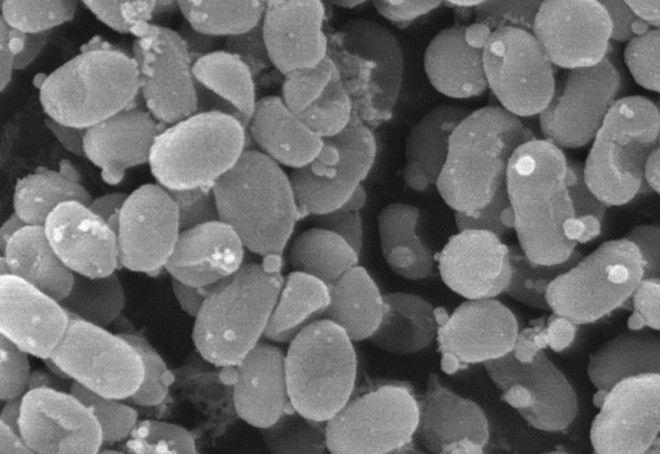
The oceans comprise the world's largest ecosystem, and cyanobacteria - single-celled organisms that get their energy through photosynthesis - are the keystone group. One type of cyanobacteria, Prochlorococcus, is the most abundant photosynthetic organism on the planet, numbering in the billion billion billions. These tiny organisms account for about 10% of all photosynthesis on Earth, which forms the base of the food chain and provides the atmosphere with oxygen. Now, researchers at the Massachusetts Institute of Technology (MIT) led by biological oceanographer Sallie Chisholm have found that cyanobacteria may play an even bigger role in the ecosystem than previously thought.
In a paper published online today in Science, Chisholm's team reports that cyanobacteria secrete vesicles - small, membrane-enclosed sacs - into the surrounding ocean. Chisholm first observed the vesicles in 2008 when one of her graduate students, Anne Thompson, spotted tiny buds on the surface of Prochlorococcus under an electron microscope. "Blebs, we called them," Chisholm recalls, "like little bubbles." A couple of years later, MIT postdoctoral fellow Steven Biller proposed that these blebs might be vesicles, based on their resemblance to vesicles from other species. He confirmed this by isolating the blebs and examining them more thoroughly under the electron microscope. The vesicles were at least as abundant as the bacteria themselves.
These initial observations were made on bacteria cultured in the lab and might not necessarily apply to wild microbes. Therefore, Biller went out into the field, collecting hundreds of liters of seawater from the coast of Massachusetts and from the Sargasso Sea near Bermuda. He found vesicles in these samples just like the ones in the laboratory cultures. Analysis of the blebs' contents revealed a variety of biological molecules: proteins, DNA, and RNA. Sequencing the DNA revealed that it came from a variety of microbes, not just Prochlorococcus. Thus, these vesicles seem to be a general feature of marine microorganisms.
Because they are so abundant, and because they contain various biomolecules, these vesicles constitute a significant source of organic carbon, nitrogen, and phosphorus on which other organisms might feed. Indeed, Chisholm and her colleagues showed that other, nonphotosynthetic bacteria can grow using the cyanobacterial vesicles as their only source of carbon. "That's kind of neat," says Marvin Whiteley, a microbiologist at the University of Texas, Austin, who wasn't involved in the study. "It really changes how we think about marine ecosystems and how they're set up and how nutrients are provided."
Another major consequence of this finding is that, in Biller's words, "it's sort of asking a lot more questions than it's answering." Perhaps the biggest new question is why the bacteria produce these vesicles in the first place. The authors offer a few hypotheses. First, cyanobacteria benefit from living among other types of bacteria. Providing vesicles as food for the other bacteria would encourage this living arrangement. Alternatively, because the vesicles contain DNA, they may facilitate the exchange of genetic material between individual bacteria, a process known as horizontal gene transfer. Last and perhaps most interesting, the vesicles may help defend against viruses. Chisholm's group showed that when viruses known to attack cyanobacteria are mixed with the vesicles, the viruses attach to the vesicles and appear to infect them as if the vesicles were living cells. The authors therefore speculate that these vesicles may function as cellular decoys, distracting the viruses so they don't infect the cyanobacteria.
Whatever their purpose, these vesicles show that we still have much to learn about life in the oceans. "We didn't set out to study this," Chisholm says, "but Prochlorococcus is always putting things in front of us to study.
This story provided by ScienceNOW, the daily online news service of the journal Science.



Reader Comments
to our Newsletter